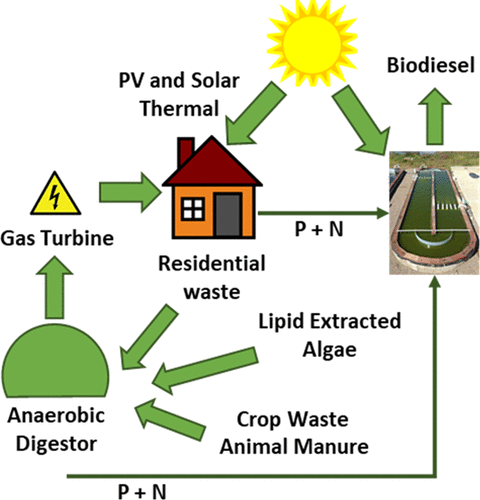当前位置:
X-MOL 学术
›
ACS Sustain. Chem. Eng.
›
论文详情
Our official English website, www.x-mol.net, welcomes your
feedback! (Note: you will need to create a separate account there.)
Algae-Powered Sustainable Community Design Life Cycle Assessment and Techno-Economic Analysis
ACS Sustainable Chemistry & Engineering ( IF 7.1 ) Pub Date : 2020-01-21 , DOI: 10.1021/acssuschemeng.9b06256 Andrew P. Bessette 1 , Ben J. Stuart 1 , Eleazer P. Resurreccion 2 , Sandeep Kumar 1
ACS Sustainable Chemistry & Engineering ( IF 7.1 ) Pub Date : 2020-01-21 , DOI: 10.1021/acssuschemeng.9b06256 Andrew P. Bessette 1 , Ben J. Stuart 1 , Eleazer P. Resurreccion 2 , Sandeep Kumar 1
Affiliation

|
Microalgae as a feedstock source for biofuels have been researched extensively over the last decade as the renewable energy community strives to find an environmentally responsible and economically feasible source of transportation fuel. This study focuses on microalgae not as a source of transportation fuel but as a fundamental pillar of sustainable rural communities seeking to achieve a net-zero energy and waste status. Sources of sustenance, waste streams, energy demands, energy production, and recycle methods are evaluated in this life cycle assessment and techno-economic analysis to determine if a rural community can achieve a state of neutrality and self-sustainability. A functional unit of 20,000 MJ/year corresponding to the energy demand of a 902-person community is modeled after a town in Georgia. The model revealed that the total available land for algae production was 7.45 ha, but only 0.02 ha was required for producing 20,000 MJ/year, our functional unit in this study. At this magnitude of algae cultivation, the energy return on investment (EROI) was 0.54 (net negative energy community) and the profitability index was only 0.04 (community is at financial loss). When the algae cultivation area is increased to 1.8 ha, an EROI of 1 is achieved; however, PI is still <1 (0.07). In order to reach PI = 1 (the break-even community), the algae cultivation area must be increased to 1.55 ha, with a corresponding EROI of 3.87. The greenhouse gas offsets for all communities were determined to be substantially larger than their emissions.
中文翻译:

藻类驱动的可持续社区设计生命周期评估和技术经济分析
在过去的十年中,随着可再生能源界努力寻找对环境负责且经济上可行的运输燃料来源,对作为生物燃料原料的微藻类进行了广泛的研究。这项研究的重点不是将微藻作为运输燃料的来源,而是将其作为寻求实现零能源和废物净状态的可持续农村社区的基本支柱。在此生命周期评估和技术经济分析中,评估了维持的来源,废物流,能源需求,能源生产和回收方法,以确定农村社区是否可以达到中立和自我维持的状态。以乔治亚州的一个城镇为模型,建立了一个20,000 MJ /年的功能单位,相当于一个902人社区的能源需求。该模型显示,藻类生产的总可用土地为7.45公顷,但生产20,000 MJ /年仅需0.02公顷,这是本研究的功能单元。在这种藻类养殖规模下,能源的投资回报率(EROI)为0.54(净负能量社区),而获利能力指数仅为0.04(社区处于财务亏损状态)。当藻类种植面积增加到1.8公顷时,EROI为1;但是,PI仍小于1(0.07)。为了使PI = 1(收支平衡社区),藻类种植面积必须增加到1.55公顷,相应的EROI为3.87。确定所有社区的温室气体抵消量都远大于其排放量。我们在这项研究中的职能部门。在这种藻类养殖规模下,能源的投资回报率(EROI)为0.54(净负能量社区),而获利能力指数仅为0.04(社区处于财务亏损状态)。当藻类种植面积增加到1.8公顷时,EROI为1;但是,PI仍小于1(0.07)。为了使PI = 1(收支平衡社区),藻类种植面积必须增加到1.55公顷,相应的EROI为3.87。确定所有社区的温室气体抵消量都远大于其排放量。我们在这项研究中的职能部门。在这种藻类养殖规模下,能源的投资回报率(EROI)为0.54(净负能量社区),而获利能力指数仅为0.04(社区处于财务亏损状态)。当藻类种植面积增加到1.8公顷时,EROI为1;但是,PI仍小于1(0.07)。为了使PI = 1(收支平衡社区),藻类种植面积必须增加到1.55公顷,相应的EROI为3.87。确定所有社区的温室气体抵消量都远大于其排放量。当藻类种植面积增加到1.8公顷时,EROI为1;但是,PI仍小于1(0.07)。为了使PI = 1(收支平衡社区),藻类种植面积必须增加到1.55公顷,相应的EROI为3.87。确定所有社区的温室气体抵消量都远大于其排放量。当藻类种植面积增加到1.8公顷时,EROI为1;但是,PI仍小于1(0.07)。为了使PI = 1(收支平衡社区),藻类种植面积必须增加到1.55公顷,相应的EROI为3.87。确定所有社区的温室气体抵消量都远大于其排放量。
更新日期:2020-01-22
中文翻译:

藻类驱动的可持续社区设计生命周期评估和技术经济分析
在过去的十年中,随着可再生能源界努力寻找对环境负责且经济上可行的运输燃料来源,对作为生物燃料原料的微藻类进行了广泛的研究。这项研究的重点不是将微藻作为运输燃料的来源,而是将其作为寻求实现零能源和废物净状态的可持续农村社区的基本支柱。在此生命周期评估和技术经济分析中,评估了维持的来源,废物流,能源需求,能源生产和回收方法,以确定农村社区是否可以达到中立和自我维持的状态。以乔治亚州的一个城镇为模型,建立了一个20,000 MJ /年的功能单位,相当于一个902人社区的能源需求。该模型显示,藻类生产的总可用土地为7.45公顷,但生产20,000 MJ /年仅需0.02公顷,这是本研究的功能单元。在这种藻类养殖规模下,能源的投资回报率(EROI)为0.54(净负能量社区),而获利能力指数仅为0.04(社区处于财务亏损状态)。当藻类种植面积增加到1.8公顷时,EROI为1;但是,PI仍小于1(0.07)。为了使PI = 1(收支平衡社区),藻类种植面积必须增加到1.55公顷,相应的EROI为3.87。确定所有社区的温室气体抵消量都远大于其排放量。我们在这项研究中的职能部门。在这种藻类养殖规模下,能源的投资回报率(EROI)为0.54(净负能量社区),而获利能力指数仅为0.04(社区处于财务亏损状态)。当藻类种植面积增加到1.8公顷时,EROI为1;但是,PI仍小于1(0.07)。为了使PI = 1(收支平衡社区),藻类种植面积必须增加到1.55公顷,相应的EROI为3.87。确定所有社区的温室气体抵消量都远大于其排放量。我们在这项研究中的职能部门。在这种藻类养殖规模下,能源的投资回报率(EROI)为0.54(净负能量社区),而获利能力指数仅为0.04(社区处于财务亏损状态)。当藻类种植面积增加到1.8公顷时,EROI为1;但是,PI仍小于1(0.07)。为了使PI = 1(收支平衡社区),藻类种植面积必须增加到1.55公顷,相应的EROI为3.87。确定所有社区的温室气体抵消量都远大于其排放量。当藻类种植面积增加到1.8公顷时,EROI为1;但是,PI仍小于1(0.07)。为了使PI = 1(收支平衡社区),藻类种植面积必须增加到1.55公顷,相应的EROI为3.87。确定所有社区的温室气体抵消量都远大于其排放量。当藻类种植面积增加到1.8公顷时,EROI为1;但是,PI仍小于1(0.07)。为了使PI = 1(收支平衡社区),藻类种植面积必须增加到1.55公顷,相应的EROI为3.87。确定所有社区的温室气体抵消量都远大于其排放量。











































 京公网安备 11010802027423号
京公网安备 11010802027423号